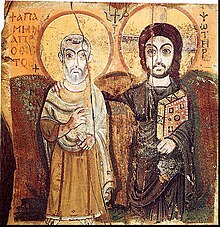Coptic art
The Coptic art is the art of the Christian descendants ( Copts ) in Egypt . It emerged from the Roman era of Egypt and remained essentially folk art throughout its development.
Christian art creation in Egypt can be divided into two phases. Before the conquest of Egypt by the Arabs in 641, the art there was practically a local variant of Byzantine art , which also had elements of ancient Egyptian art. After the conquest , it continued to develop and flourished in the 7th to 9th centuries. With the increasing Islamization of the Egyptian population, there was a decline in Coptic art since the 13th century.
In painting , the frontal view of individual figures is predominant. The people appear static and have their gaze directed at the viewer. As a result, they often appear transcendent and transfigured. There is mostly the representation of standing, rarely seated figures. Narrative representations are the exception. Plasticity is seldom implied. A rich book illumination exists up to the 17th century ; In addition, monumental wall paintings are known from monastery churches. In addition, there is an extensive repertoire of representations on countless Coptic textiles, which at the beginning still refer to classical-ancient motifs, but gradually turn to Christian themes.
There is hardly any evidence of round sculptural works, on the other hand the relief in the form of architectural jewelry experienced a special bloom. These reliefs are carved in stone, but also cut in wood. Here, too, comparable style features can be found. The figures are shown frontally, appear rigid and partly schematic. The heads are often shown oversized. Here, too, there is a remarkable persistence of ancient motifs. Scenes from Greek sagas were popular and may have been reinterpreted in Christian terms.
In terms of architecture, important church buildings ( basilicas ) arose in the early days , while the Middle Ages were characterized by the construction of large monasteries throughout Egypt. These buildings are mostly made of adobe bricks, but important components such as B. Pillars, in stone.
The largest and most important collection of Coptic art is now in the Coptic Museum in Cairo.
literature
- Arne Effenberger : Coptic Art, Egypt in Late Antique, Byzantine and Early Islamic Times . Vienna 1976, ISBN 3-85504-037-0 .
- Mahmoud Zibawi: Coptic Art. Christian Egypt from late antiquity to the present. Schnell and Steiner, Regensburg 2004, ISBN 3-7954-1562-4 .
- Keyword “Coptic Art”, in: Meyers Enzyklopädisches Lexikon . Bibliographical Institute, Mannheim / Vienna / Zurich 1973, Volume 14, p. 211.

